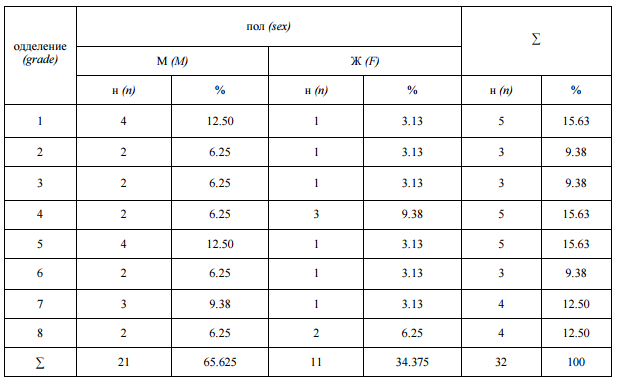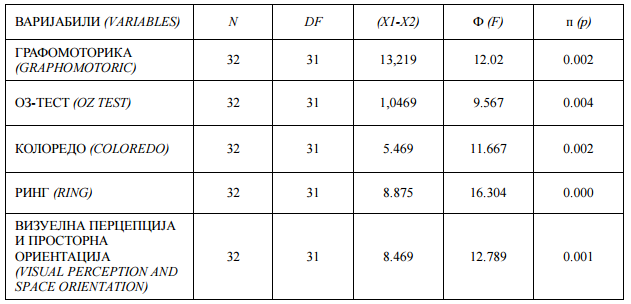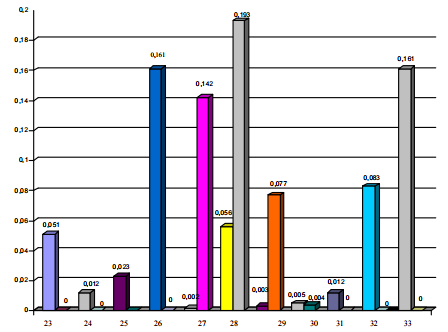JSER Policies
JSER Online
JSER Data
Frequency: quarterly
ISSN: 1409-6099 (Print)
ISSN: 1857-663X (Online)
Authors Info
- Read: 3032
|
ОПТОВАРЕНОСТА НА ЦЕРЕБРАЛНО ПАРАЛИЗИРАНИТЕ УЧЕНИЦИ ПРИ УСВОЈУВАЊЕТО НА ОПЕРАТИВНИТЕ ЗАДАЧИ НА НАСТАВАТА ОД ЛИКОВНАТА КУЛТУРА И ОЧЕКУВАНИ ПОСТИГНУВАЊА
Радмила ЧУКИЌ 1 Мехо ШУТКОВИЌ 2
Факултет за специјална едукација и рехабилитација 1 |
|
HARDSHIPS OF CEREBRAL PALSY PUPILS IN ACQUIRING FINE ARTS CLASSES TASKS AND EXPECTED ACCOMPLISHMENTS
Radmila CHUKIKJ 1
Faculty for Special Education and Rehabilitation 1 |
|
|
|
UDK: 37.036-052.26 |
|
Вовед |
|
Introduction |
|
Образовно-воспитната работа со церебрално парализираните ученици во основното училиште „Миодраг Матиќ“ се реализира според посебни, модифицирани планови и програми за ментално ретардирани ученици. Тоа се однесува и на плановите и програмите за ликовната култура. Последниве години е регистриран забележителен дебаланс помеѓу психомоторните способности на учениците и резултатите во реализирањето на програмските содржини од ликовната култура, што беше и мотив на ова истражување. |
|
The educational program of cerebral palsy pupils in the elementary school “Miodrag Matich” is carried out according to special, modified plans and programs for mentally retarded students. This also refers to the plans and programs for fine arts. In the resent years, a huge dis-balance has been noticed between the cognitive and movement abilities of pupils and the realization of the program contents of fine arts classes, which was the main motive of this research. |
|
|
|
|
|
Методологија на истражувањето |
|
Research methodology |
|
Наставниот план и програма по кои се спроведува образовно-воспитната работа со церебрално парализираните ученици, всушност е модифицирана верзија на плановите и програмите за образовно-воспитната работа со ментално ретардираните ученици. Така е и со предметот ликовна култура. Поентата на ова истражување е испитување на односот на психомоторните способности на учениците, плановите и програмите за ликовна култура и нивоата на постигнувањата, а со цел внесување на одредени измени и дополнувања во програмата на ликовната култура, заради подобро прилагодување на психомоторните способности на церебрално парализираните ученици. |
|
Program contents for cerebral palsy pupils in the elementary school are a modification of the program contents for pupils with mental retardation. However, those program contents are not adjusted with cognitive and movement abilities of cerebral palsy pupils, thus, they have difficulties in learning those program contents. This especially refers to subjects for acquiring skills. This research referred to the adjusted cognitive and movement abilities of the students, program contents for the subject arts culture and the expected results. |
|
|
|
|
|
Примерок, време и место на истражување |
|
Sample, time and place of research |
|
Примерокот го формиравме од 32 ученика од Специјалното основно училиште за церебрално парализирани деца „Миодраг Матиќ“. Со испитувањето беа опфатени сите ученици од 1 - 8 одделение. Испитувањето на способностите на церебрално парализираните деца е извршено во Белград, во Основното училиште „Миодраг Матиќ“ во Павиљонот 1, ул. „Сокобањска“ 17 и во Павиљонот 2 на ул. „Браќа Јерковиќ“ 5. |
|
The sample was made in the elementary school “Miodrag Matic“, a special school for cerebral palsy pupils. The research included a group of 32 pupils from the 1st to the 8th grade. The examination of cerebral palsy pupils was held in Belgrade, in the elementary school “Miodrag Matic“, in Pavilion I, 17 Sokobanjska Str., and Pavilion II, 5 Brace Jerkovic Str. |
|
Табела 1. Структура на испитаниците според полот и возраста |
|
Table 1. Structure of the examinees according to sex and age |

|
Подгрупа Б (н=16) - испитаници со високи психомоторни способности. |
|
Subgroup B (n=16) - examinees with higher cognitive and movement abilities. |
|
Табела 2. Структура на испитаниците според полот и постоењето на физички деформитети |
|
Table 2. Structure of the examinees according to sex and existence of physical deformities |

|
Табела 3. Структура на испитаниците според полот и оштетувањето на видот |
|
Table 3. Structure of the examinees according to sex and vision impairment |
 |
|
Табела 4. Структура на испитаните според полот и постоењето на додатни деформитети |
|
Table 4. Structure of the examinees according to sex and existence of additional deformities |
 |
|
Варијабили на истражувањето и користени тестови |
|
Research variables and tests |
|
Варијабилите на истражувањето се поделени на две групи: |
|
Research variables are divided into two groups: |
|
Втората група варијабили се однесува на психомоторните способности на испитаниците:
|
|
The second group of variables is related to the psycho-motor capabilities of the examinees:
|
|
|
|
|
|
Резултати |
|
Results |
|
|
|
|
|
Табела 5. Резултати на тестирањето на меѓугрупни разлики меѓу подгрупите А и Б |
|
Table 5.Results of testing of intergroup diferences between subgroups A and B |
 |

|
Слика 1. Графички приказ на резултатите од тестирањето на оперативните задачи 1-11 |
|
Figure1. Graphicshow of the testing results of operational assignments 1-11 |

|
Слика 2. Графички приказ на резултатите од тестирањето на оперативните задачи 12-22 |
|
Figure 2. Graphic show of the testing results of operational assignments 12-22 |

|
Слика 3. Графички приказ на резултатите од тестирањето на оперативните задачи 23-33 |
|
Figure 3. Graphicshow of the testing results of operational assignments34-44 |

|
Слика 4. Графички приказ на резултатите од тестирањето на оперативните задачи 34-44 |
|
Figure 4. Graphicshow of the testing results of operational assignments34-44 |
|
Дискусија |
|
Discussion |
||
|
Ипитувањата на графомоторните способности, моториката на горните екстремитети, визуелната перцепција и просторната ориентација, укажуваат на смалени моторни способности на учениците со церебрална парализа. Табелата бр. 5 го прикажува тестирањето на меѓугрупните разлики за релевантните варијабили од кои можеме да видиме дека за графомоториката е утврдено постоење на статистичка значајност на ниво 0,002. |
|
The examination of the graphomotoric capabilities, the motorics of the upper extremities, of the visual perception and spatial orientation, indicates to lowered motoric capabilities of the students with cerebral palsy. Table 5 shows the differences in the testing between groups, for relevant variables, from which we can see that statistic relevance, on the 0.002 level, has been determined for graphomotorics. |
||
|
|
|
|
||
|
Заклучок |
|
Conclusions |
||
|
Со ова истражување покажавме дека нивото на психомоторните способности на учениците со церебрална парализа битно влијае на усвојувањето на програмските содржини, а причината лежи во неусогласеноста на наставните планови и програми од ликовната култура со психомоторните способности на церебрално парализираните ученици, што сигурно не е стимулативно за нивниот развој. |
|
With this research, we have shown that the level of psychomotor capabilities of the students with cerebral palsy very much affects the implementation of the curriculum contents; the cause of which lies in the inconsistency of the curriculum plans and fine arts programs with psychomotor capabilities of the students with cerebral palsy, which is certainly not stimulation for their development. |
||
|
|
|
|
||
|
Citation:Chukikj R, Eminovikj F, Shutkovikj M. Hardships of Cerebral Palsy Pupils in Acquiring Art Classes Tasks and Excpeted Accomplishments. J Spec Educ Rehab 2008; 9(1-2):77-85. |
||||
|
|
||||
|
Литература / References |
|
|
||
|
|
|
||
|
|
||||
Share Us
Journal metrics
-
 SNIP 0.059
SNIP 0.059 -
 IPP 0.07
IPP 0.07 -
 SJR 0.13
SJR 0.13 -
 h5-index 7
h5-index 7 -
 Google-based impact factor: 0.68
Google-based impact factor: 0.68
Related Articles
10 Most Read Articles
- PARENTAL ACCEPTANCE / REJECTION AND EMOTIONAL INTELLIGENCE AMONG ADOLESCENTS WITH AND WITHOUT DELINQUENT BEHAVIOR
- RELATIONSHIP BETWEEN LIFE BUILDING SKILLS AND SOCIAL ADJUSTMENT OF STUDENTS WITH HEARING IMPAIRMENT: IMPLICATIONS FOR COUNSELING
- EXPERIENCES FROM THE EDUCATIONAL SYSTEM – NARRATIVES OF PARENTS WITH CHILDREN WITH DISABILITIES IN CROATIA
- INOVATIONS IN THERAPY OF AUTISM
- AUTISM AND TUBEROUS SCLEROSIS
- THE DURATION AND PHASES OF QUALITATIVE RESEARCH
- REHABILITATION OF PERSONS WITH CEREBRAL PALSY
- DISORDERED ATTENTION AS NEUROPSYCHOLOGICAL COGNITIVE DISFUNCTION
- HYPERACTIVE CHILD`S DISTURBED ATTENTION AS THE MOST COMMON CAUSE FOR LIGHT FORMS OF MENTAL DEFICIENCY
- DIAGNOSTIC AND TREATMENT OPTIONS IN AUTISTIC SPECTRUM DISORDERS – AN OVERVIEW
















